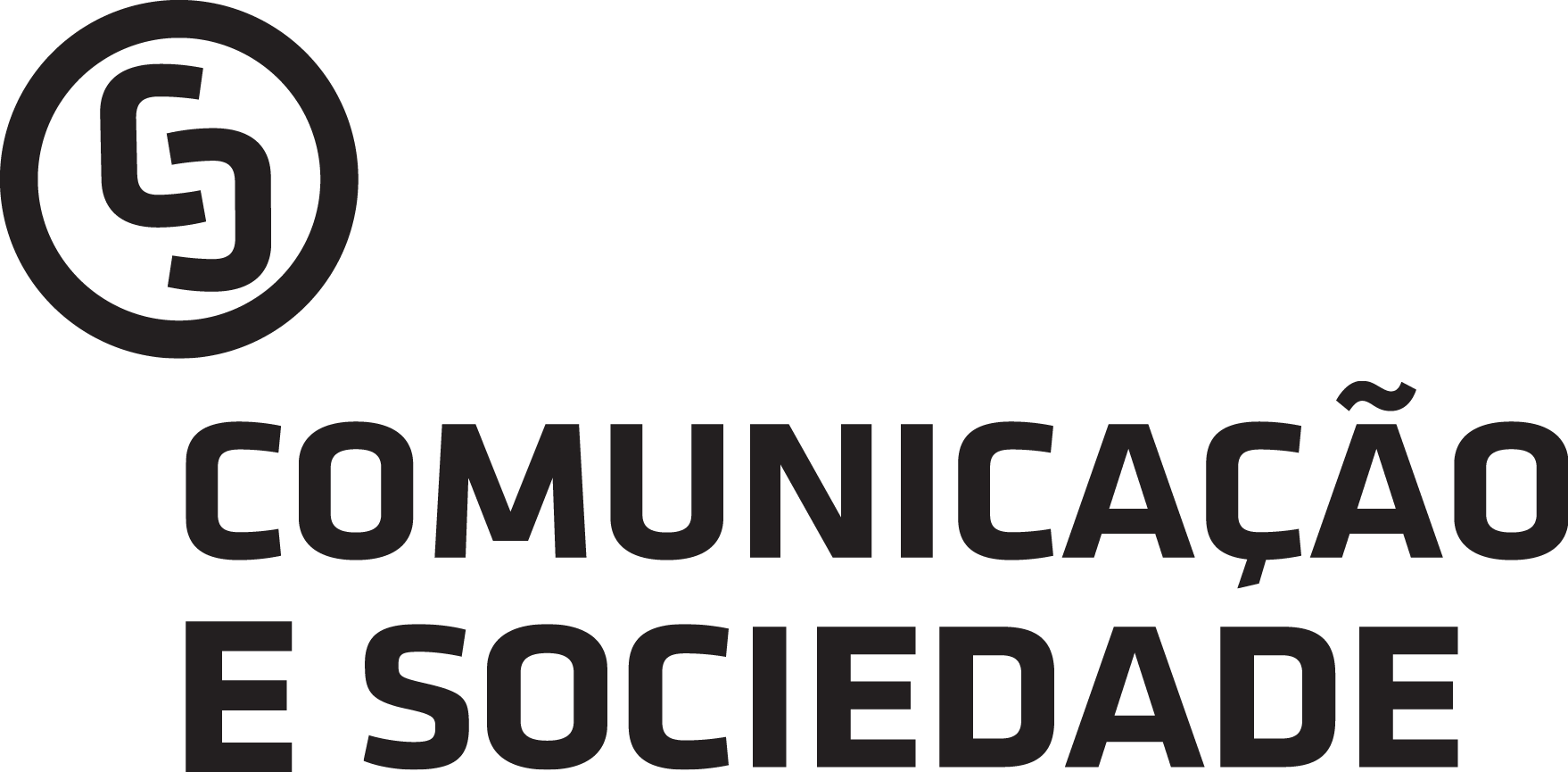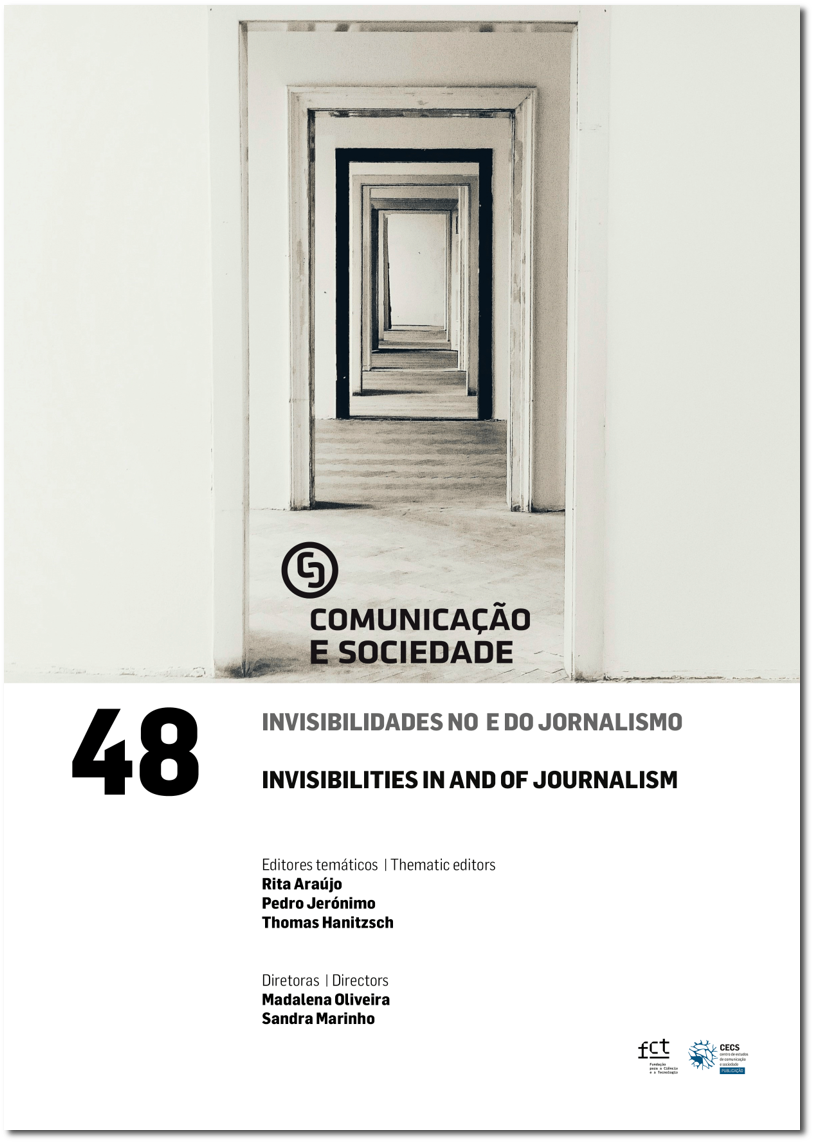Evolução da Representação Fotográfica das Mulheres nas Primeiras Páginas da Imprensa Espanhola (1977–1997): Uma Análise Comparativa do ABC e do El País
DOI:
https://doi.org/10.17231/comsoc.48(2025).6429Palavras-chave:
estudos de género, análise de conteúdo visual, fotografias, primeiras páginas, transição espanholaResumo
O objetivo desta investigação é analisar a evolução da representação fotográfica das mulheres nas primeiras páginas dos jornais ABC e El País, com base numa amostra por conveniência de todas as edições de março entre 1977 e 1997. O método de investigação utilizado foi a análise de conteúdo visual (Neuendorf, 2017). As unidades de análise foram obtidas através dos arquivos digitais dos jornais, especificamente das secções de arquivo das primeiras páginas. Das 1.300 primeiras páginas examinadas, 242 fotografias incluíam mulheres. Para além da dimensão quantitativa, também foram considerados os aspetos interpretativos da representação visual. Esta abordagem dupla permite não só medir frequências, como compreender as implicações culturais e ideológicas das representações. A presença de mulheres nas primeiras páginas continua a ser minoritária em comparação com a dos homens, normalmente não ultrapassando 10–15%. Os resultados revelam que o ABC reforça os papéis tradicionais e a representação decorativa das mulheres, enquanto o El País destaca a sua presença política e laboral, embora com ênfase na vitimização. A análise evidencia como estas fotografias moldaram uma narrativa visual de género na imprensa, restringindo a visibilidade e o reconhecimento das mulheres nas esferas política e profissional. A extrapolação destes resultados para o presente mostra que os estereótipos visuais persistem, sendo reproduzidos não só em ambientes digitais, como também em imagens geradas por inteligência artificial.
Downloads
Referências
Amores, J. J., Arcila-Calderón, C., & González-de-Garay, B. (2020). The gendered representation of refugees using visual frames in the main Western European media. Gender Issues 37, 291–314. https://doi.org/10.1007/s12147-020-09248-1
Arguiñano, J.-L., & Goikoetxea Bilbao, U. (2020). Analysis of headlines and front page photographs in Spain in the context of the coronavirus crisis: Protagonists, frames and war language. Journal of Communication and Health, 10(2), 1–23. https://doi.org/10.35669/rcys.2020.10(2).1-23
Aznar, M. P. M., Rodríguez-Wangüemert, C., & Morales, I. E. (2017). Representation of women and men in Spanish press. Revista Latina de Comunicación Social, (72), 765–782. https://doi.org/10.4185/RLCS-2017-1191
Bachmann, I. 2022). News media coverage of women. Communication. https://doi.org/10.1093/obo/9780199756841-0278
Bell, P. (2001). Content analysis of visual images. In T. van Leeuwen & C. Jewitt (Eds.), Handbook of visual analysis (pp. 10–34). SAGE.
Carlsson, F., Kataria, M., & Lampi, E. (2024). Sexual objectification of women in media and the gender wage gap: Does exposure to objectifying pictures lower the reservation wage? Journal of Behavioral and Experimental Economics, 108, Article 102157. https://doi.org/10.1016/j.socec.2023.102157
Castillo, N. G. (2014). The image of Spanish women in press photography during the Civil War. Content analysis applied to the main Portuguese newspapers. Historia y Comunicación Social, 19, 781–795. https://doi.org/10.5209/rev_HICS 2014.v19.45002
Chen, Y., Zhai, Y., & Sun, S. (2024). The gendered lens of AI: Examining news imagery across digital spaces. Journal of Computer-Mediated Communication, 29(1), Article zmad047. https://doi.org/10.1093/jcmc/zmad047
De-Miguel, R., Hanitzsch, T., Parrat, S., & Berganza, R. (2017). Women journalists in Spain: An analysis of the sociodemographic features of the gender gap. El Profesional de la Información, 26(3), 497–506. https://doi.org/10.3145/epi.2017.may.16
Fagoaga de Bartolomé, C., & Secanella, P. M. (1984). Threshold of women’s presence in the Spanish press. Instituto de la Mujer; Ministerio de Cultura.
Fernández Fraile, M. E. (2008). History of women in Spain: History of a conquest. La Aljaba, 12, 11–20.
Fernández García, N. (2015). Es una mujer, está embarazada… Es la ministra de Defensa. Un análisis comparativo de la representación mediática de la primera mujer ministra de Defensa de la historia española. Communication Papers. Media Literacy and Gender Studies, 4(7), 35–46. https://doi.org/10.33115/udg_bib/cp.v4i07.22047
Fernández García, N. (2016). Framing gender and women politicians representation: Print media coverage of spanish women ministers. In C. Cerqueira, R. Cabecinhas, & I. Magalhães (Eds.), Gender in focus: (New) trends in media (pp. 141–160). CECS.
Gaitán Moya, J. A. (1992). La opinión de El País en la transición española. REIS: Revista Española de Investigaciones Sociológicas, 57, 149–166. https://doi.org/10.5477/cis/reis.57.149
Gallagher, M. (2015). Foreword. In S. Macharia (Ed.), Who makes the news? (pp. 1–2). World Association for Christian Communication.
Gallego-Ayala, J. (2015). De reinas a ciudadanas: Medios de comunicación ¿motor o rémora para la igualdad? UOC.
García, C. (2022, March 7). 8M: La mujer en la universidad: 20 años de mayor participación (y de segregación). CYD Foundation. https://www.fundacioncyd.org/mujer-en-la-universidad-evolucion-20-anos-participacion-segregacion/
García Orosa, B., & Gallur Santorum, S. (2019). La presencia de la mujer en las informaciones de los cibermedios europeos de España, Italia, Gran Bretaña, Portugal y Francia. Revista Latina de Comunicación Social, 74, 403–417. https://doi.org/10.4185/RLCS-2019-1337
Gehrke, M., & Amit-Danhi, E. R. (2025, June 26). Gendered disinformation as violence: A new analytical agenda. Harvard Kennedy School: Misinformation Review. https://doi.org/10.37016/mr-2020-177
Gill, R. (2012). Media, empowerment and the ‘sexualization of culture’ debates. Sex Roles, 66, 736–745. https://doi.org/10.1007/s11199-011-0107-1
Goldman, R., Heath, D., & Smith, S. L. (1991). Commodity feminism. Critical Studies in Mass Communication, 8(3), 333–351. https://doi.org/10.1080/15295039109366801
Gómez y Patiño, M. (2011). Analysis of the treatment of women in the Spanish press. International Women’s Day. Estudios Sobre el Mensaje Periodístico, 17(1), 119–140. https://doi.org/10.5209/rev_ESMP.2011.v17.n1.7
Gómez-Escalonilla Moreno, G., García Jiménez, A., Santín Durán, M., Rodríguez Díaz, R., & Torregrosa Carmona, J. F. (2008). La imagen de la mujer política en los medios de comunicación. Feminismo/s, (11), 59–71. https://doi.org/10.14198/fem.2008.11.04
Gunther, R., Montero, J. R., & Wert, J. I. (1999). The media and politics in Spain: From dictatorship to democracy. Working papers: Institut de Ciències Polítiques i Socials, (176), 1–46.
Hernández Herrera, M. (2019). La representación de la mujer en la viñeta española: Construcción y participación femenina. Estudios Sobre el Mensaje Periodístico, 25(2), 869–882. https://doi.org/10.5209/esmp.64812
Huber, E., Stephens, J. D., Bradley, D., Moller, S., & Nielsen, F. (2009). The politics of women’s economic independence. Social Politics: International Studies in Gender, State & Society, 16(1), 1–39. https://doi.org/10.1093/sp/jxp005
Ibáñez, S., & Mar, M. del. (2016). Women and men in the Spanish press: The journalistic interpretation of reality. Feminismo/s, (27), 147–164. https://doi.org/10.14198/fem.2016.27.08
Jia, S., Lansdall-Welfare, T., Sudhahar, S., Carter, C., & Cristianini, N. (2016). Women are seen more than heard in online newspapers. PLoS ONE, 11(2), Article e0148434. https://doi.org/10.1371/journal.pone.0148434
Kress, G., & van Leeuwen, T. (2006). Reading images: The grammar of visual design. Routledge.
Krippendorff, K. (1990). Metodología de análisis de contenido: Teoría y práctica (L. Wolfson, Trans.). Paidós. (Original work published 1980)
Larrondo Ureta, A. (2019). (In)visibility of feminism in the media: The depiction of the second-wave women’s movement in Spain. Feminist Media Studies, 20(1), 70–85. https://doi.org/10.1080/14680777.2019.1574856
Leyton, E. V., Simone, L. D., Gómez-Lorenzini, P., Labarca, C., & Guevara-Iturbe, A. (2024). Representation of women in authoritarian Chile. An approach from advertising. Historia y Comunicación Social, 29(1), 189–200. https://doi.org/10.5209/hics.92116
Locke, L. G., Hodgdon, G. (2024). Gender bias in visual generative artificial intelligence systems and the socialization of AI. AI & Society, 40, 2229–2236. https://doi.org/10.1007/s00146-024-02129-1
López, T. M. O. (2020). Against feminism. Mobilisation, repression and sublimation of the traditional female model in the first half of the 20th century in Spain. Revista de Humanidades, 41, 157–180. https://doi.org/10.5944/rdh.41.2020.24030
Matud, M. P., Rodríguez-Wangüemert, C. R., & Espinosa, I. (2012). Representation of women and men in Spanish national press news. Cuestiones de Género: De la Igualdad y la Diferencia, 7, Article 09. https://doi.org/10.18002/cg.v0i7.900
Montero, M., Rodríguez-Virgili, J., & García Ortega, C. (2008). The political role of the press in Spanish transition to democracy, 1975-1978. Javnost - The Public, 15(4), 5–20. https://doi.org/10.1080/13183222.2008.11008979
Neuendorf, K. (2017). The content analysis guidebook. SAGE. https://doi.org/10.4135/9781071802878
Orduña Prada, M. (2019). Prensa y radio del Movimiento en los albores de la transición: A propósito del decreto-ley sobre libertad de expresión. Historia Actual Online, 48, 103–113. https://doi.org/10.36132/hao.v1i48.1762
Pérez Fernández, F. (2016). Evolution of thinking about women in Spain from the late nineteenth to the twenty-first century: Romanticism, the labour market, violence and equality. Pensamiento Americano, 9(16), 121–142.
Prieto-Sánchez, C. (2018). ¿Quiénes hablan en las noticias? Desequilibrio de género en las fuentes informativas de la prensa de proximidad. Zer, 23(45), 161–184. https://doi.org/10.1387/zer.20261
Ramos Palomo, M. D., & Ortega Muñoz, V. J. (2020). Gladiator women. Republican women’s press and political mobilisation in the beginnings of media culture in Spain (1896-1922). RIHC. Revista Internacional de Historia de la Comunicación, 2(15), 16–41. https://doi.org/10.12795/RiHC.2020.i15.02
Santoniccolo, F., Trombetta, T., Paradiso, M. N., & Rollè, L. (2023). Gender and media representations: A review of the literature on gender stereotypes, objectification and sexualization. International Journal of Environmental Research and Public Health, 20(10), Article 5770. https://doi.org/10.3390/ijerph20105770
Schiller, H. I. (1976). Communication and cultural domination. International Arts and Sciences Press.
Smythe, D. W. (1977). Communications: Blindspot of Western Marxism. Canadian Journal of Political and Social Theory, 1(3), 1–27.
Soto, M., Luzón, V., Fernández Quijada, D., Ramajo, N., Blanch, M., Franquet Calvet, M. R., & Ribes Guardia, F. X. (2004). Representación de género en los principales medios de comunicación online. Instituto de las Mujeres. https://www.inmujeres.gob.es/publicacioneselectronicas/documentacion/Documentos/DE0101.pdf
Suárez-Romero, M., & Ortega-Pérez, A. M. (2019). Gender and opinion. The secondary role of women in journalistic spaces. iQual. Revista de Género e Igualdad, 2, 133–146. https://doi.org/10.6018/iQual.324321
Taha, B., & Fahmy, S. S. (2023). Where are all the women? A cross-cultural analysis of women in online news. Newspaper Research Journal. Advance online publication. https://doi.org/10.1177/07395329231206373
Tankosic, M. M., Grbic, A. V., & Krivokapic, Z. (2020). The marginalization and exploitation of women in media industry. In M. Bošković (Ed.), Globalization and its impact on violence against vulnerable groups (pp. 75–94). IGI Global.
Tirocchi, S., & Taddeo, G. (2024). Unveiling informal learning of gender roles on TikTok: The #Stayathomegirlfriends phenomenon. International Communication Gazette, 86(5), 399–419. https://doi.org/10.1177/17480485241259836
Torralbo Ruiz, Á. (2011). El rol de la mujer en el Código Civil: Especial referencia a los efectos personales del matrimonio [Master’s thesis, University of Salamanca]. Gredos. http://hdl.handle.net/10366/101364
UN Women. (2025, September 4). Half the world, only a quarter of the news: Women appear or are heard in just 26 per cent of all broadcast, radio and print clips [Press release]. https://www.unwomen.org/en/news-stories/press-release/2025/09/half-the-world-only-a-quarter-of-the-news
Van der Pas, D. J., & Aaldering, L. (2020). Gender differences in political media coverage: A meta-analysis. Journal of Communication, 70(1), 114–143. https://doi.org/10.1093/joc/jqz046
Ward, L. M. (2016). Media and sexualization: State of empirical research, 1995–2015. The Journal of Sex Research, 53(4–5), 560–577. https://doi.org/10.1080/00224499.2016.1142496
Zafra-Arroyo, A. M., & Öksüz, O. (2025). Turkey’s accession process to the EU in the Spanish press: Constructing otherness through language and news images. Online Journal of Communication and Media Technologies, 15(3), Article e202522. https://doi.org/10.30935/ojcmt/16593
Downloads
Publicado
Como Citar
Edição
Secção
Licença
Direitos de Autor (c) 2025 Ana María Zafra Arroyo

Este trabalho encontra-se publicado com a Licença Internacional Creative Commons Atribuição 4.0.
Os autores são titulares dos direitos de autor, concedendo à revista o direito de primeira publicação. O trabalho é licenciado com uma Licença Creative Commons - Atribuição 4.0 Internacional.












